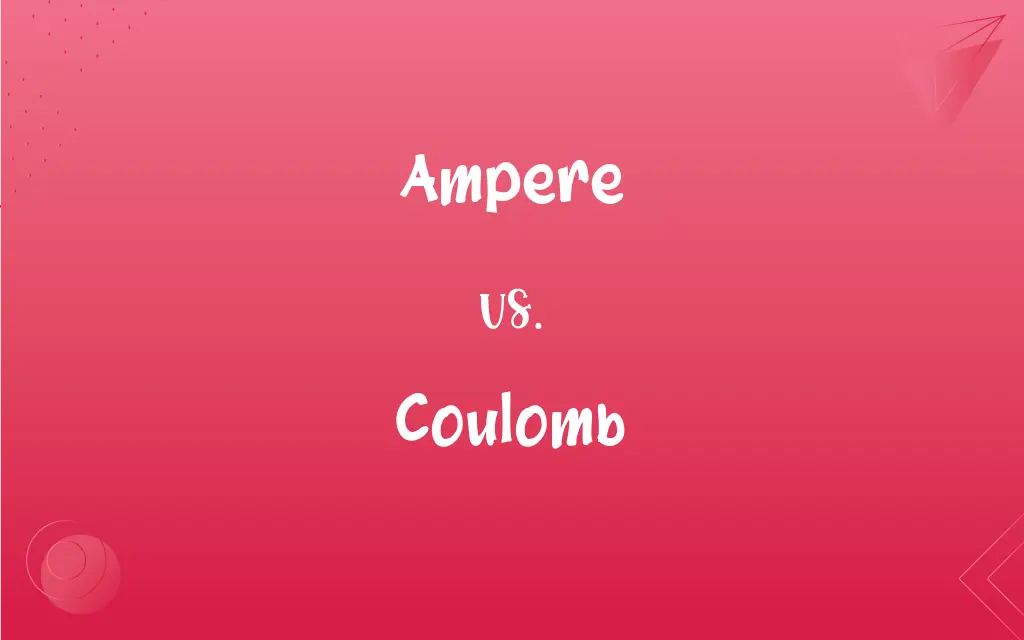Ampere vs. Coulomb: What's the Difference?
Edited by Aimie Carlson || By Harlon Moss || Published on December 30, 2023
Ampere is a unit of electric current, measuring flow of charge per second, whereas Coulomb is a unit of electric charge, representing the quantity of electricity conveyed.

Key Differences
An ampere (A) is the standard unit of electric current in the International System of Units (SI), representing the steady current produced by one volt driving a one-ohm resistance. A coulomb (C) quantifies electric charge, equivalent to the charge transported by a current of one ampere in one second.
Amperes measure the flow rate of electric charge, analogous to water flow in a river. In contrast, coulombs measure the total quantity of electricity, similar to the volume of water in a container.
The concept of amperes is integral in calculating electrical flow in circuits, crucial for designing electrical systems. Coulombs are key in understanding static electricity and electrochemical processes, where total charge plays a vital role.
Amperes are used in practical applications like determining the capacity of electrical wires and safety devices. Coulombs are used in contexts like battery capacities and electrostatic experiments.
The relationship between amperes and coulombs is direct; one ampere is one coulomb of charge passing a point per second, emphasizing their interdependence in electrical theory.
ADVERTISEMENT
Comparison Chart
Definition
Unit of electric current
Unit of electric charge
Measurement
Flow of charge per second
Quantity of electricity conveyed
SI Units Relation
1 A = 1 C/s
1 C = Charge transported by 1 A in 1 sec
Practical Application
Used in determining wire capacity
Used in measuring battery capacity
Related Concepts
Integral in circuit design
Important in static electricity, electrochemistry
ADVERTISEMENT
Ampere and Coulomb Definitions
Ampere
Symbolized as 'A'.
The device requires a current of 0.5 amperes.
Coulomb
Symbolized as 'C'.
The capacitor was rated for 100 microcoulombs.
Ampere
A measure of electric current.
The circuit has a current of 2 amperes.
Coulomb
Relates to electric potential.
The field strength was measured in volts per coulomb.
Ampere
Represents charge flow per second.
The charger operates at 1 ampere.
Coulomb
A unit of electric charge.
The battery stores 5000 coulombs of charge.
Ampere
Unit of electric current in SI.
Most household wiring is rated for 15-20 amperes.
Coulomb
Measures quantity of electricity.
The static discharge was a few coulombs.
Ampere
Integral in electrical engineering.
Calculating the load, he factored in amperes.
Coulomb
Used in electrochemistry.
The reaction required a transfer of 2 coulombs.
Ampere
The basic unit of electric current, equal to one coulomb per second and equivalent to the current, flowing in two straight parallel wires of negligible cross section separated by a distance of one meter, that produces a force between the wires of 2.0 × 10-7 newtons per meter of length. The value of an ampere in the International System differs very slightly from that in the meter-kilogram-second-ampere system of units. See Table at measurement.
Coulomb
The basic unit of electric charge, equal to the quantity of charge transferred in one second by a steady current of one ampere, and equivalent to 6.2415 × 1018 elementary charges, where one elementary charge is the charge of a proton or the negative of the charge of an electron. A coulomb's value in the International System differs very slightly from that in the meter-kilogram-second-ampere system of units. See Table at measurement.
Ampere
A unit of electrical current, the standard base unit in the International System of Units; colloquially amp. Abbreviation: amp, Symbol: A
Definition: The ampere, symbol A, is the SI unit of electric current. It is defined by taking the fixed numerical value of the elementary charge e to be 1.602
X 10−19 when expressed in the unit C, which is equal to A
S, where the second is defined in terms of ΔνCs. ([https://www.bipm.org/en/si-base-units/ampere The International Bureau of Weights and Measures])
Coulomb
Of or relating to the Coulomb force.
Ampere
The unit of electric current; - defined by the International Electrical Congress in 1893 and by U. S. Statute as, one tenth of the unit of current of the C. G. S. system of electro-magnetic units, or the practical equivalent of the unvarying current which, when passed through a standard solution of nitrate of silver in water, deposits silver at the rate of 0.001118 grams per second. Called also the international ampère.
Coulomb
In the International System of Units, the derived unit of electric charge; the amount of electric charge carried by a current of 1 ampere flowing for 1 second. Symbol: C
He is charged up with enough coulombs to make his hair stand on end.
Ampere
A former unit of electric current (slightly smaller than the SI ampere)
Coulomb
The standard unit of quantity in electrical measurements. It is the quantity of electricity conveyed in one second by the current produced by an electro-motive force of one volt acting in a circuit having a resistance of one ohm, or the quantity transferred by one ampère in one second. Formerly called weber.
Ampere
The basic unit of electric current adopted under the Systeme International d'Unites;
A typical household circuit carries 15 to 50 amps
Coulomb
A unit of electrical charge equal to the amount of charge transferred by a current of 1 ampere in 1 second
Coulomb
French physicist famous for his discoveries in the field of electricity and magnetism; formulated Coulomb's Law (1736-1806)
FAQs
How is ampere related to voltage and resistance?
Ampere relates to voltage and resistance by the formula I (Ampere) = V (Voltage) / R (Resistance).
Is the ampere a base unit in SI?
Yes, the ampere is a base unit in the SI system.
Is ampere used in calculating electrical energy?
Yes, amperes are used in calculating electrical energy.
How is coulomb related to electrons?
One coulomb is approximately equal to the charge of 6.242 x 10^18 electrons.
Can we measure household electricity in amperes?
Yes, household electrical systems are typically measured in amperes.
What is the symbol for ampere?
The symbol for ampere is 'A'.
Are amperes related to power consumption?
Yes, amperes are directly related to power consumption in electrical devices.
What does an ampere measure?
An ampere measures the flow of electric current.
What does a coulomb represent?
A coulomb represents a unit of electric charge.
Is the coulomb a fundamental unit in physics?
Yes, the coulomb is a fundamental unit in the study of electricity.
Is coulomb used in battery capacity measurements?
Yes, battery capacities can be measured in coulombs.
What is the symbol for coulomb?
The symbol for coulomb is 'C'.
How are coulombs used in electrostatics?
Coulombs are used to measure the amount of static charge in electrostatics.
Can coulombs be converted to other units?
Yes, coulombs can be converted to other units like ampere-hours.
How do we measure current using amperes?
Current is measured using an ammeter, which displays the current in amperes.
Can coulombs be seen in weather phenomena?
Yes, lightning strikes involve the transfer of a large number of coulombs.
What are common uses of the ampere in daily life?
Amperes are used in everyday life to rate electrical appliances and circuit breakers.
How does ampere relate to electric fields?
Amperes are linked to electric fields in terms of the force they exert on charged particles.
Are coulombs involved in chemical reactions?
Yes, coulombs are involved in electrochemical reactions, measuring the charge transferred.
Is there a standard for measuring amperes?
Yes, the International System of Units provides the standard for measuring amperes.
About Author
Written by
Harlon MossHarlon is a seasoned quality moderator and accomplished content writer for Difference Wiki. An alumnus of the prestigious University of California, he earned his degree in Computer Science. Leveraging his academic background, Harlon brings a meticulous and informed perspective to his work, ensuring content accuracy and excellence.
Edited by
Aimie CarlsonAimie Carlson, holding a master's degree in English literature, is a fervent English language enthusiast. She lends her writing talents to Difference Wiki, a prominent website that specializes in comparisons, offering readers insightful analyses that both captivate and inform.






































































